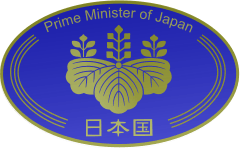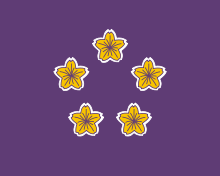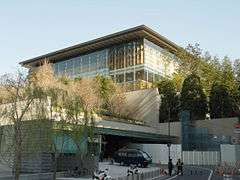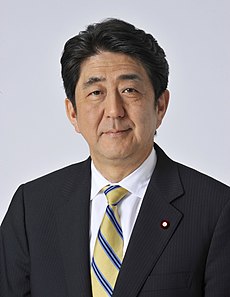Prime Minister of Japan
The prime minister of Japan (内閣総理大臣, Naikaku-sōri-daijin, or Shushō (首相)) is the head of government of Japan and the commander-in-chief of the Japanese Armed Forces. The prime minister is appointed by the Emperor of Japan after being designated by the National Diet and must enjoy the confidence of the House of Representatives to remain in office. He is the head of the Cabinet and appoints and dismisses the other ministers of state. The literal translation of the Japanese name for the office is Minister for the Comprehensive Administration of (or the Presidency over) the Cabinet.
| Prime Minister of Japan 内閣総理大臣 | |
|---|---|
 Emblem of the Prime Minister of Japan | |
| Style | His Excellency |
| Residence | Kantei |
| Nominator | National Diet |
| Appointer | His Imperial Majesty The Emperor of Japan |
| Term length | Four years or fewer, renewable indefinitely.[lower-alpha 1] |
| Inaugural holder | Itō Hirobumi |
| Formation | 22 December 1885 |
| Salary | ¥ 22,190,000 annually[1] |
| Website | www.kantei.go.jp |
 |
|---|
| This article is part of a series on the politics and government of Japan |
|
|
|
|
History
Before the adoption of the Meiji Constitution, Japan had in practice no written constitution. Originally, a Chinese-inspired legal system known as ritsuryō was enacted in the late Asuka period and early Nara period. It described a government based on an elaborate and rational meritocratic bureaucracy, serving, in theory, under the ultimate authority of the Emperor; although in practice, real power was often held elsewhere, such as in the hands of the Fujiwara clan, who intermarried with the Imperial Family in the Heian period, or by the ruling shōgun. Theoretically, the last ritsuryō code, the Yōrō Code enacted in 752, was still in force at the time of the Meiji Restoration.
Under this system, the Daijō-daijin (太政大臣, Chancellor of the Realm)[2] was the head of the Daijō-kan (Department of State), the highest organ of Japan's pre-modern Imperial government during the Heian period and until briefly under the Meiji Constitution with the appointment of Sanjō Sanetomi in 1871. The office was replaced in 1885 with the appointment of Itō Hirobumi to the new position of Prime Minister,[3] four years before the enactment of the Meiji Constitution, which mentions neither the Cabinet nor the position of Prime Minister explicitly.[4][5] It took its current form with the adoption of the Constitution of Japan in 1947.
To date, 62 people have served this position. Shinzō Abe is the current prime minister. He re-took the office on December 26, 2012. He is the first former Prime Minister to return to office since 1948, and the longest serving Prime Minister to date.
Appointment
The Prime Minister is designated by both houses of the Diet, before the conduct of any other business. For that purpose, each conducts a ballot under the run-off system. If the two houses choose different individuals, then a joint committee of both houses is appointed to agree on a common candidate. Ultimately, however, if the two houses do not agree within ten days, the decision of the House of Representatives is deemed to be that of the Diet. Therefore, the House of Representatives can theoretically ensure the appointment of any Prime Minister it wants.[6] The candidate is then presented with his or her commission, and formally appointed to office by the Emperor.[7]
In practice, the Prime Minister is almost always the leader of the majority party in the House of Representatives, or the leader of the senior partner in the governing coalition.
Qualifications
- Must be a member of either house of the Diet. (This implies a minimum age of 25 and a Japanese nationality requirement.)
- Must be a "civilian". This excludes serving members of the Japan Self-Defense Forces. Former military persons may be appointed prime minister despite the "civilian" requirement, Yasuhiro Nakasone being one prominent example.
Role
Constitutional roles
- Exercises "control and supervision" over the entire executive branch.[8]
- Presents bills to the Diet on behalf of the Cabinet.[9]
- Signs laws and Cabinet orders (along with other members of the Cabinet).[10]
- Appoints all Cabinet ministers, and can dismiss them at any time.[11]
- May permit legal action to be taken against Cabinet ministers.[12]
- Must make reports on domestic and foreign relations to the Diet.[9]
- Must report to the Diet upon demand to provide answers or explanations.[13]
- May advise the Emperor to dissolve the Diet's House of Representatives.[14]
Statutory roles
- Presides over meetings of the Cabinet.[15]
- Commander-in-chief of the Japan Self-Defense Forces.[16]
- May override a court injunction against an administrative act upon showing of cause.[17]
Unlike most of his counterparts in constitutional monarchies, the Prime Minister is both de jure and de facto chief executive. In most other constitutional monarchies, the monarch is nominal chief executive, while being bound by convention to act on the advice of the cabinet. In contrast, the Constitution of Japan explicitly vests executive power in the Cabinet, of which the Prime Minister is the leader. His countersignature is required for all laws and Cabinet orders. While most ministers in parliamentary democracies have some freedom of action within the bounds of cabinet collective responsibility, the Japanese Cabinet is effectively an extension of the Prime Minister's authority.
Insignia
 Standard of the Prime Minister
Standard of the Prime Minister Emblem of the Prime Minister
Emblem of the Prime Minister Mon (crest) of the Prime Minister
Mon (crest) of the Prime Minister
Official office and residence

Located near the Diet building, the Office of the Prime Minister of Japan is called the Kantei (官邸). The original Kantei served from 1929 until 2002, when a new building was inaugurated to serve as the current Kantei.[18] The old Kantei was then converted into the Official Residence, or Kōtei (公邸).[19] The Kōtei lies to the southwest of the Kantei, and is linked by a walkway.[19]
Travel
The Prime Minister of Japan travels in a Lexus LS 600h L,[20] the official transport for the head of government, or an unmodified Toyota Century escorted by a police motorcade of numerous Toyota Celsiors.
For long distance air travel, Japan maintains two Boeing 747-400 aircraft mostly for the Prime Minister of Japan, the Emperor, Empress and other members of the Imperial Family, operated by the Japan Air Self-Defense Force.
They have the radio callsigns Japanese Air Force One and Japanese Air Force Two when operating on official business, and Cygnus One and Cygnus Two when operating outside of official business (e.g., on training flights). The aircraft always fly together on government missions, with one serving as the primary transport and the other serving as a backup with maintenance personnel on board. The aircraft are officially referred to as Japanese government exclusive aircraft (日本国政府専用機, Nippon-koku seifu sen'yōki).[21]
The aircraft were constructed at the Boeing factory at the same time as the U.S. Air Force One VC-25s, though the U.S. aircraft were built to the 747-200 design, while the Japanese aircraft were built to the more contemporary 747-400 design. Both Japanese aircraft were delivered in 1990.[22] The 747s will be replaced by new Boeing 777-300ER aircraft in fiscal year 2019.[23]
Honours and emoluments
Until the mid-1930s, the Prime Minister of Japan was normally granted a hereditary peerage (kazoku) prior to leaving office if he had not already been ennobled. Titles were usually bestowed in the ranks of count, viscount or baron, depending on the relative accomplishments and status of the Prime Minister. The two highest ranks, marquess and prince, were only bestowed upon highly distinguished statesmen, and were not granted to a Prime Minister after 1928. The last Prime Minister who was a peer was Baron Kijūrō Shidehara, who served as Prime Minister from October 1945 to May 1946. The peerage was abolished when the Constitution of Japan came into effect in May 1947.
Certain eminent Prime Ministers have been awarded the Order of the Chrysanthemum, typically in the degree of Grand Cordon. The highest honour in the Japanese honours system, the Collar of the Order of the Chrysanthemum, has only been conferred upon select Prime Ministers and eminent statesmen; the last such award to a living Prime Minister was to Saionji Kinmochi in 1928. More often, the Order of the Chrysanthemum has been a posthumous distinction; the Collar of the order was last awarded posthumously to former Prime Minister Eisaku Satō in June 1975. The Grand Cordon has typically been posthumously awarded; the most recent such award was to Ryutaro Hashimoto in July 2006.
After relinquishing office, the Prime Minister is normally accorded the second or senior third rank in the court order of precedence, and is usually raised to the senior second rank posthumously. Certain distinguished Prime Ministers have been posthumously raised to the first rank; the last such award was to Sato Eisaku in 1975. Since the 1920s, following their tenure in office, Prime Ministers have typically been conferred with the Grand Cordon of the Order of the Paulownia Flowers (until 2003 a special higher class of the Order of the Rising Sun), depending on tenure and eminence. However, honours may be withheld due to misconduct or refusal on the part of the Prime Minister (for example, Kiichi Miyazawa).
See also
Notes
- The Cabinet shall resign en masse after a general election of members of the House of Representatives. Their term of office is four years which can be terminated earlier. No limits are imposed on the number of terms or tenures the Prime Minister may hold. The Prime Minister is, by convention, the leader of the victorious party, though some prime ministers have been elected from junior coalition partners or minority parties.
References
- "IG.com Pay Check". IG.
- Kenkyusha's New Japanese-English Dictionary, Kenkyusha Limited, ISBN 4-7674-2015-6
- Legal framework for Prime Minister and Cabinet in the Empire: Dajōkan proclamation No. 69 of December 22, 1885 (内閣職権, naikaku shokken), later replaced by Imperial edict No. 135 of 1889 (内閣官制, naikaku kansei) Archived March 3, 2016, at the Wayback Machine in effect until 1947
- Article 55 of the Imperial Constitution only bound the ministers of state, i.e. all members of the cabinet including the prime minister, to "give their advice to the Emperor and be responsible for it."
- Kantei: Cabinet System of Japan
- Article 67 of the Constitution of Japan
- Article 6 of the Constitution of Japan
- Article 5 of the Constitution of Japan
- Article 72 of the Constitution of Japan
- Article 74 of the Constitution of Japan
- Article 68 of the Constitution of Japan
- Article 75 of the Constitution of Japan
- Article 63 of the Constitution of Japan
- Article 7 of the Constitution of Japan
- Cabinet Act2012, article 4
- Self-Defense Forces Act of 1954
- Administrative Litigation Act, article 27
- Nakata, Hiroko (March 6, 2007). "The prime minister's official hub". The Japan Times Online. The Japan Times. Retrieved October 21, 2007.
- "A virtual tour of the former Kantei – Annex etc. – The Residential Area". Prime Minister of Japan. Retrieved October 21, 2007.
- Sanchanta, Mariko; Inada, Miho (February 4, 2010). "Toyota's Influence Looms Over Japan". The Wall Street Journal. Archived from the original on May 29, 2015. Retrieved May 13, 2010.
- 政府専用機にそもそも「専用機材」は必要なのか?, Newsweek Japan, Feb 25, 2011.
- Hardesty, 2005
- "Japan chooses Boeing 777-300ER as government's official jet". Japan Times. Jiji. August 12, 2014. Retrieved August 13, 2014.
- Kenkyusha's New Japanese-English Dictionary, Kenkyusha Limited, Tokyo 1991, ISBN 4-7674-2015-6
External links
| Wikimedia Commons has media related to Prime ministers of Japan. |
- Prime Minister of Japan and His Cabinet Official website
- List of Japanese cabinets 1885 to 1989 (in Japanese)


.jpg)